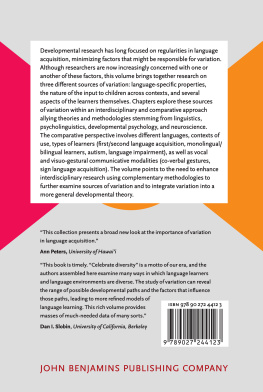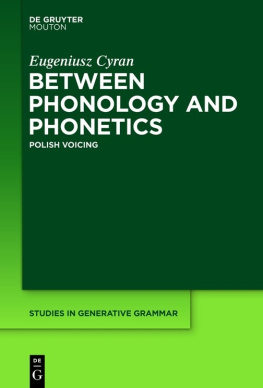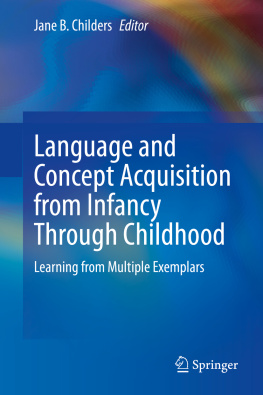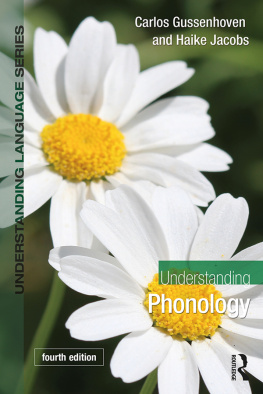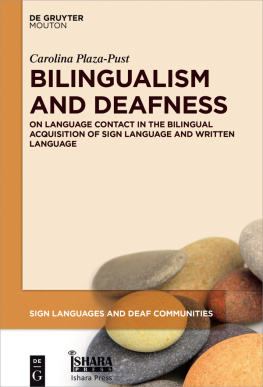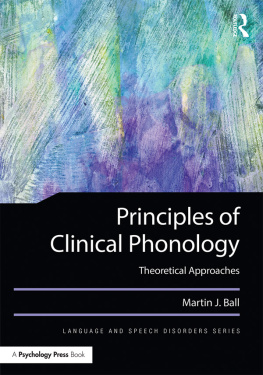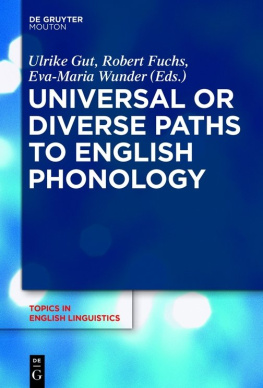Judith A. Gierut, Michele L. Morrisette, and Katherine M. Brown
Contemporary research on language acquisition has been dominated by models that appeal to statistical regularities of the input to guide childrens learning (Aslin, Saffran, & Newport, 1999; Jusczyk, 1997; Kelly & Martin, 1994). These models make use of the probabilistic occurrence of language-specific structures to predict the developmental course, speed, and accuracy of learning. Evidence in support of probabilistic proposals has come primarily from experimental psycholinguistic studies of English (Edwards, Beckman, & Munson, 2004; Jusczyk, Luce, & Charles-Luce, 1994; Storkel, 2001).
This theoretical perspective stands in sharp contrast to early foundational research on language acquisition, which was dominated by universalist models (Chomsky, 1999; Ferguson, 1977; Jakobson, 1941/1968). The intent was to instantiate formal principles of language in the context of acquisition to gain insight into the range and variation of possible grammars and their change over time. Supporting evidence came largely from longitudinal cross-linguistic descriptions (de Boysson-Bardies & Vihman, 1991; Ingram, 1988; Locke, 1983).
This chapter aims to unite psycholinguistic and linguistic perspectives by exploring the link between language-specific input statistics and universal principles in acquisition. The focus was on phonotactic probability as the language-specific variable and syllable well-formedness as the universal principle. Two computational studies of the developing mental lexicon of English are reported. The purpose was to determine whether the distribution of words in the child lexicon best aligns with phonotactic probability, principles of well-formedness, or some combination of the two. A brief overview of the variables of interest, framed within the context of acquisition, provides the background and motivation for the hypotheses to be tested.
Probabilistic Phonotactics
The developing mental lexicon is said to be organized into neighborhoods, which consist of phonetically similar forms defined by one-phoneme substitutions, deletions, or additions (Luce, 1986). Words with many phonetically similar counterparts make dense neighborhoods e.g., cat has neighbors mat, hat, sat, cot, kit, cut, cap, can, catch among others (as retrieved from http://neighborhoodsearch.wustl.edu) whereas words with few similar counterparts make sparse neighborhoodse.g., push has just three neighbors, bush, pull, put (as retrieved from http://neighborhoodsearch.wustl.edu). One hypothesis is that children initiate the language acquisition process by building dense neighborhoods (Jusczyk et al., 1994). They acquire and add new words to their developing lexicon that overlap in phonological form (Walley, 1993). Support for this idea comes from computational studies, which show that childrens early words are phonologically more similar than the words they learn later (Storkel, 2004a). The neighborhoods of children also tend to be denser than those of adults (Coady & Aslin, 2003; cf. Charles-Luce & Luce, 1990, 1995). Behavioral evidence from perception shows too that infants encode words from dense neighborhoods with enough phonetic detail to detect mispronunciations (Swing-ley & Aslin, 2002). Moreover, in production, toddlers readily acquire new words that are comprised of IN sounds, which occur in the phonetic inventory, as opposed to OUT sounds, which do not (Schwartz & Leonard, 1982). Likewise, toddlers produce the sounds that occur in words from dense neighborhoods more accurately than those from sparse neighborhoods (Sosa & Stoel-Gammon, 2012). This pattern of performance continues through mid-childhood and beyond because preschoolerswith and without language learning disordersbenefit from dense neighborhoods for purposes of word learning (Demke, Graham, & Siakaluk, 2002), phonological learning (Gierut & Morrisette, 2012), syntactic learning (Hoover & Storkel, 2013), and metalinguistic awareness (De Cara & Goswami, 2003). Thus, the organization of phonetically similar words into dense neighborhoods appears to have multifaceted consequences for language acquisition (Stoel-Gammon, 2011).
A related observation is that the developing mental lexicon of English is largely comprised of Consonant-Vowel-Consonant (CVC) words (Charles-Luce & Luce, 1990). The CVC words in dense neighborhoods are further made up of the most commonly occurring sounds of English (Coady & Aslin, 2003; Storkel, 2013). More precisely, neighborhood density is positively correlated with phonotactic probability (Vitevitch & Luce, 1999). Phonotactic probability is the statistical likelihood of sounds and sound sequences in a given language (Vitevitch & Luce, 2004 for English; http://www.people.ku.edu/~mvitevit/PhonoProbHome.html) and is computed as the sum of segment frequency (SSF) and/or the sum of biphone frequency (SBF). SSF reflects the likelihood of a given sound occurring in a given position relative to all other possible segments in the language, whereas SBF reflects the likelihood of the occurrence of pairs of sounds relative to all other pairs in that language. The greater the SSF or SBF value, the more common the phonological form.
As with neighborhood density, studies have shown that phonotactic probability affects language acquisition. In perception, Jusczyk et al. (1994) showed that infants listen longer to words that consist of common as opposed to rare phonotactic patterns. In production, Beckman and Edwards (2000) found that preschoolers imitate nonwords composed of common sound sequences more accurately than rare sequences. Storkel (2001) likewise found that phonotactic probability influences childrens acquisition and retention of novel words. It is important to clarify that phonotactic probability is independent of normative age of sound mastery (Storkel, 2013). Phonotactic probability is based on the statistical regularity of sounds in the target language input, whereas normative age of sound mastery is based on the cross-sectional order of acquisition of sounds in childrens outputs.
The relevance of these data is that they offer a testable prediction about the composition of the developing lexicon of English from the vantage of language-specific input statistics. Specifically, it is predicted that the developing lexicon will contain a greater proportion of CVC words with common as opposed to rare phonotactic patterns; this is one hypothesis to be tested herein.
Syllable Well-Formedness
It has long been thought that the syllable is a prosodic bootstrap to language acquisition (Gleitman & Wanner, 1982). The syllable has been described as the frame from which the lexical and phonological content emerge (MacNeilage & Davis, 1990). Numerous studies have described the range of syllable types produced by children and their corresponding orders of emergence (Ingram, 1978; Levelt, Schiller, & Levelt, 2000; Lle & Prinz, 1997; Vihman, 1992). The data are rich, capturing the use of syllables beginning in the earliest stages of babbling. The data are also detailed, highlighting cross-linguistic similarities and differences.
Complementary experimental work has further demonstrated that children are sensitive to the internal structure of syllables. In perception, infants detect commonalities among syllables based on properties of the onset (Juscyzk, Goodman, & Baumann, 1999). In production, childrens erred outputs implicate the syllable, such that simplifications and reductions affect unstressed units (Gerken & McGregor, 1998). Other production studies have found that childrens learning is differentially affected by exposure to different types of syllable structure (Gierut, 1999; Gierut & Champion, 2001). Syllables with branching onsets (i.e., clusters), for example, induce greater phonological learning than syllables comprised of adjuncts /sp-/, /st-/, /sk-/. Finally, metalinguistic research has demonstrated that preliterate children are able to accurately judge and manipulate words based on syllables (Treiman & Breaux, 1982). This ability emerges well before children have explicit knowledge of the syllable as a linguistic unit.




